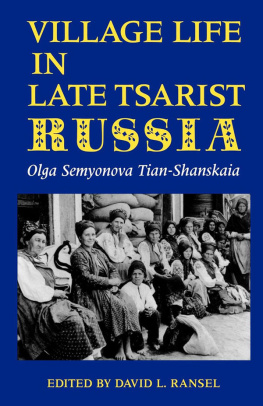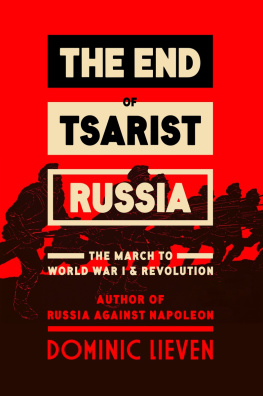Late Tsarist Russia, 18811913
This book brings together the large volume of work on late Tsarist Russia published over the last 30 years, to show an overall picture of Russia under the last two tsars before the war brought down not only the Russian empire but also those of Germany, Austria-Hungary, and Turkey. It turns the attention from the old emphases on workers, revolutionaries, and a reactionary government, to a more diverse and nuanced picture of a country which was both a major European great power, facing the challenges of modernization and industrialization, and also a multi-ethnic and multi-confessional empire stretching across both Europe and Asia.
Beryl Williams is an Emeritus Reader in History at the University of Sussex.
Routledge Studies in the History of Russia and Eastern Europe
Creating Nationality in Central Europe, 18801950
Modernity, Violence and (Be)Longing in Upper Silesia
Edited by James Bjork, Tomasz Kamusella, Timothy Wilson, and Anna Novikov
The Russian Liberals and the Revolution of 1905
Peter Enticott
The Politics of Culture in Soviet Azerbaijan, 192040
Audrey L Altstadt
Women's Experiences of Repression in the Soviet Union and Eastern Europe
Kelly Hignett, Melanie Ilic, Dalia Leinarte and Corina Snitar
Leadership and Nationalism in Azerbaijan
Ali Mardan bey Topchibashov, Founder and Creator
Jamil Hasanli
Everyday Soviet Utopias
The Planning, Design and the Aesthetics of Developed Socialism
Anna Alekseyeva
Tourism and Travel during the Cold War
Negotiating Tourist Experiences across the Iron Curtain
Sune Bechmann Pedersen and Christian Noack
Soviet Women-Everyday Lives
Melanie Ilic
Late Tsarist Russia, 18811913
Beryl Williams
For a full list of available titles please visit: www.routledge.com/Routledge-Studies-in-the-History-of-Russia-and-Eastern-Europe/book-series/SE0329
Late Tsarist Russia, 18811913
Beryl Williams
First published 2021
by Routledge
2 Park Square, Milton Park, Abingdon, Oxon OX14 4RN
and by Routledge
52 Vanderbilt Avenue, New York, NY 10017
Routledge is an imprint of the Taylor & Francis Group, an informa business
2021 Beryl Williams
The right of Beryl Williams to be identified as author of this work has been asserted by her in accordance with sections 77 and 78 of the Copyright, Designs and Patents Act 1988.
All rights reserved. No part of this book may be reprinted or reproduced or utilized in any form or by any electronic, mechanical, or other means, now known or hereafter invented, including photocopying and recording, or in any information storage or retrieval system, without permission in writing from the publishers.
Trademark notice: Product or corporate names may be trademarks or registered trademarks, and are used only for identification and explanation without intent to infringe.
British Library Cataloguing-in-Publication Data
A catalogue record for this book is available from the British Library
Library of Congress Cataloging-in-Publication Data
A catalog record has been requested for this book
ISBN: 978-0-367-54778-3 (hbk)
ISBN: 978-1-003-09058-8 (ebk)
Typeset in Times New Roman
by Wearset Ltd, Boldon, Tyne and Wear
For Ken
Contents
I have basically followed the revised Library of Congress transliteration except for well-known names like Tolstoy, Dostoevsky, and Gorky, where I have kept the more familiar y ending.
All dates are old style, that is in the Julian calendar, which Russia maintained until February 1918. Thus dates are 12 days before the Western calendar in the nineteenth century and 13 days before it in the twentieth century.
I am greatly indebted to the work of the Study Group on the Russian Revolution and grateful to Professor Robin Milner-Gulland and to Professor Christina Lodder for their comments on .
Events in the present affect the way historians see the past. One of the best examples of this is the re-evaluation of Russian and Soviet history, which started under Gorbachevs policy of glasnost (openness), in the late 1980s and has continued since the fall of the Soviet Union. Initially concerned with the Stalinist period, this has led, in both Russia and the West, to a fundamental re-think of Late Tsarist Russia as well as the Soviet period generally. New archival sources have become available, particularly from the provinces and from the newly independent states. Moreover, old assumptions have been challenged and new topics explored, leading to a radically changed picture of the years before the First World War. There has been a cultural turn and an imperial turn, to name but two of the new fields of study, and interest in areas of the country and in sections of the population previously neglected. The long-standing argument between positive and negative views of the prospects for Imperial Russia and the monarchy by 1914 has been re-visited, with more, although by no means all, historians taking, if with reservations, a more positive approach a line which this book follows. Few, if any, would now argue that Russia was on course for a revolution as the Romanov dynasty celebrated its tercentenary in 1913.
Indeed by then the country, socially, economically, and culturally, was booming. Certainly there was political stagnation, and various problems, some more insoluble than others, and many of which were common to other European powers, but Russia was one of the largest economies in the world with a vibrant and growing civil society, an artistic life at the forefront of European culture, a large and modernizing army and the second biggest air-force in Europe. If peace had been preserved in 1914, Russias history could have been very different. This book aims to bring together some of the large volume of work on the period published over the last 30 years, to show an overall picture of Russia under the last two tsars before the war brought down, not only the Russian empire but also those of Germany, Austria-Hungary, and Turkey. It turns the attention from the old emphases on workers, revolutionaries, and a reactionary government, to a more diverse and nuanced picture of a country which was both a major European great power, facing the challenges of modernization and industrialization, and also a multi-ethnic and multi-confessional empire stretching across both Europe and Asia.
Studies of provincial towns and areas have shifted attention away from St Petersburg and Moscow, and painted a rather different picture of the interests and concerns of the population away from the capitals. Studies of non-Russian and non-Orthodox areas of the empire have raised new questions about the governance of an imperial landmass in an age of rising nationalism. New ideas of nationality, citizenship, and class, as well as the inevitable social consequences of industrialization and urbanization, clashed with an autocratic government concerned to preserve the traditional estate system (soslovie), which divided Russian society into nobility, clergy, merchants, and peasants, into which so many new groups of people increasingly did not fit. The result was a period of conflict, complexity, and confusion, but which produced an extraordinarily vibrant society in rapid change, which makes the period between the assassination of Alexander II and the First World War of particular interest.








